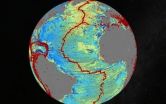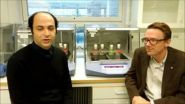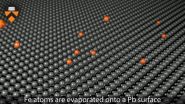(Press-News.org) A "mini-stroke" may increase your risk of developing post-traumatic stress disorder (PTSD), according to new research in the American Heart Association journal Stroke.
Transient ischemic attack (TIA), like stroke, is caused by restricted blood supply to the brain. A TIA is temporary and often lasts less than five minutes, without causing permanent brain damage.
"We found one in three TIA patients develop PTSD," said Kathrin Utz, Ph.D., a study author and post-doctoral researcher in the Department of Neurology at the University of Erlangen-Nuremberg in Germany.
"PTSD, which is perhaps better known as a problem found in survivors of war zones and natural disasters, can develop when a person experiences a frightening event that poses a serious threat."
The study is the first to analyze whether a TIA and the knowledge of an increased risk for stroke can lead patients to develop psychiatric problems.
After examining data from 108 TIA patients with no prior history of stroke and reviewing participants' answers to a series of questionnaires that evaluated their mental state, German and British researchers found:
About 30 percent of patients with TIA disclosed symptoms of PTSD.
About 14 percent of all TIA patients showed significantly reduced mental quality of life and 6.5 percent had reduced physical quality of life.
Those with PTSD showed higher signs of depression, anxiety and reduced quality of life.
Patients' fear of having a stroke and poor coping behaviors after a TIA may be partially to blame for them developing PTSD.
"While their fear is partly justified, many patients may be overestimating their risk and increasing their chances of developing PTSD," Utz said.
"When experienced together, the symptoms from TIA and depression pose a significant psychological burden on the affected patient; therefore, it comes as no surprise that we also found TIA patients with PTSD have a measurably lower sense of quality of life."
Even a brief neurological disorder, which in itself doesn't lead to a chronic disability, can be just as traumatic as an event like a traffic accident or natural disaster, researchers said. The way a patient normally responds to stressful situations may help determine their risk of developing PTSD after a TIA.
"Patients who use certain types of coping strategies, such as denying the problem, blaming themselves for any difficulties or turning to drugs for comfort, face a greater risk of developing PTSD after TIA," Utz said.
"It is not yet entirely clear why some people develop PTSD following a TIA, but others do not. However, what we do know at this stage is that younger patients and patients who in general find it difficult to cope with stress are more likely to develop psychological problems following a TIA."
Utz suggests providing patients better risk counselling and more positive adaptive strategies to cope with TIA.
INFORMATION:
Lead author of the study is Ines C. Kiphuth, M.D. Co-authors are Adam J. Noble, Ph.D.; Martin Köhrmann, M.D.; and Thomas Schenk, Ph.D.
Author disclosures and funding information are on the manuscript.
Additional Resources:
Post-traumatic stress disorder linked to death, atherosclerosis in veterans
Why Rush? TIA is an Emergency
How does depression affect the heart?
Follow AHA/ASA news on Twitter @HeartNews.
For stroke science, follow Stroke at @StrokeAHA_ASA.
Statements and conclusions of study authors published in American Heart Association scientific journals are solely those of the study authors and do not necessarily reflect the association's policy or position. The association makes no representation or guarantee as to their accuracy or reliability. The association receives funding primarily from individuals; foundations and corporations (including pharmaceutical, device manufacturers and other companies) also make donations and fund specific association programs and events. The association has strict policies to prevent these relationships from influencing the science content. Revenues from pharmaceutical and device corporations are available at http://www.heart.org/corporatefunding
'Mini-stroke' may lead to post-traumatic stress disorder
American Heart Association Rapid Access Journal Report
2014-10-02
ELSE PRESS RELEASES FROM THIS DATE:
Treatment to reduce blood clots otolaryngology in patients admitted for surgery examined
2014-10-02
Bottom Line: The effectiveness of a treatment to reduce blood clots among otolaryngology patients admitted for surgery appears to differ based on patient risk and the procedure.
Author: Vinita Bahl, D.M.D., M.P.P., of the University of Michigan Health System, Ann Arbor, and colleagues.
Background: Blood clots (venous thromboembolism [VTE], which includes deep vein thrombosis [DVT] and pulmonary embolism [PE]) are common complications in surgical patients. Treatment (primary thromboprophylaxis with anticoagulant medication [chemoprophylaxis]) can help reduce the incidence ...
Osteoporosis treatment may also benefit breast cancer patients
2014-10-02
This news release is available in French.
Montreal October 2, 2014 – Treatment approaches to reduce the risk of bone complications (metastasis) associated with breast cancer may be one step closer to becoming a reality. According to a study led by a team at the Research Institute of the McGill University Health Centre (RI-MUHC), findings show that medication used to treat bone deterioration in post-menopausal women may also slow skeletal metastasis caused from breast cancer. This study, published in this month's issue of the Journal of the National Cancer Institute ...
University of Maryland School of Medicine identifies new heart disease pathway
2014-10-02
National Institutes of Health, University of Maryland School of Medicine, Canadian Institutes of Health Research New research by scientists at the University of Maryland School of Medicine (UM SOM) and the Ottawa Heart Institute has uncovered a new pathway by which the brain uses an unusual steroid to control blood pressure. The study, which also suggests new approaches for treating high blood pressure and heart failure, appears today in the journal Public Library of Science (PLOS) One.
"This research gives us an entirely new way of understanding how the brain and the ...
Researchers discover gene that can predict aggressive prostate cancer at diagnosis
2014-10-02
Researchers at The University of Texas MD Anderson Cancer Center have identified a biomarker living next door to the KLK3 gene that can predict which GS7 prostate cancer patients will have a more aggressive form of cancer.
The results reported in the journal of Clinical Cancer Research, a publication of the American Association of Cancer Research, indicate the KLK3 gene – a gene on chromosome 19 responsible for encoding the prostate-specific antigen (PSA) – is not only associated with prostate cancer aggression, but a single nucleotide polymorphism (SNP) on it is more ...
New map uncovers thousands of unseen seamounts on ocean floor
2014-10-02
Scientists have created a new map of the world's seafloor, offering a more vivid picture of the structures that make up the deepest, least-explored parts of the ocean.
The feat was accomplished by accessing two untapped streams of satellite data.
Thousands of previously uncharted mountains rising from the seafloor, called seamounts, have emerged through the map, along with new clues about the formation of the continents.
Combined with existing data and improved remote sensing instruments, the map, described today in the journal Science, gives scientists new tools ...
In-depth analysis of bat influenza viruses concludes they pose low risk to humans
2014-10-02
Zoonosis—transmission of infections from other vertebrates to humans—causes regular and sometimes serious disease outbreaks. Bats are a well-known vertebrate reservoir of viruses like rabies and Ebola. Recent discovery of sequences in bats that are resemble influenza virus genes raised the question of whether bat flu viruses exist and could pose a threat to humans. A study published on October 2nd in PLOS Pathogens addresses this question based on detailed molecular and virological characterization.
Because no infectious virus particles were isolated from the bat samples ...
Study of mountain lion energetics shows the power of the pounce
2014-10-02
Scientists at the University of California, Santa Cruz, using a new wildlife tracking collar they developed, were able to continuously monitor the movements of mountain lions in the wild and determine how much energy the big cats use to stalk, pounce, and overpower their prey.
The research team's findings, published October 3 in Science, help explain why most cats use a "stalk and pounce" hunting strategy. The new "SMART" wildlife collar--equipped with GPS, accelerometers, and other high-tech features--tells researchers not just where an animal is but what it is doing ...
Thermotolerant yeast can provide more climate-smart ethanol
2014-10-02
VIDEO:
This is a video interview with Jens Nielsen.
With a simple mutation, yeast can grow in higher than normal temperatures. Researchers at Chalmers University of Technology demonstrate this in an article...
Click here for more information.
With a simple mutation, yeast can grow in higher than normal temperatures. Researchers at Chalmers University of Technology demonstrate this in an article to be published in the scientific journal Science. The findings may result in ethanol ...
Cheetahs never prosper: Energy expenditure linked to population decline
2014-10-02
Wild cheetah populations have declined precipitously in the past century: from an estimated 100,000 in 1900 to only around 10,000 today. A new study from researchers in Europe, South Africa and at North Carolina State University suggests that the energy cheetahs spend looking for prey, rather than their high-speed hunting tactics or food stolen by other predators, may be to blame for their dwindling numbers.
Cheetahs are high-speed hunters, but are not the strongest predators in their ecosystems. Often, hyenas and lions will take advantage of this, stealing the cheetah's ...
Princeton scientists observe elusive particle that is its own antiparticle
2014-10-02
VIDEO:
Princeton University researchers first deposited iron atoms onto a lead surface to create an atomically thin wire. They then used a scanning-tunneling microscope to create a magnetic field and to...
Click here for more information.
Princeton University scientists have observed an exotic particle that behaves simultaneously like matter and antimatter, a feat of math and engineering that could yield powerful computers based on quantum mechanics.
Using a two-story-tall microscope ...
LAST 30 PRESS RELEASES:
The (metabolic) cost of life
CFRI special issue call for papers: New Frontiers in Sustainable Finance
HKU Engineering scholar demonstrates the smallest all-printed infrared photodetectors to date
Precision empowerment for brain "eavesdropping": CAS team develops triple-electrode integrated functional electrode for simultaneous monitoring of neural signals and chemical transmitters during sleep
Single-capillary endothelial dysfunction resolved by optoacoustic mesoscopy
HKU three research projects named among ‘Top 10 Innovation & Technology News in Hong Kong 2025’ showcasing excellence in research and technology transfer
NLRSeek: A reannotation-based pipeline for mining missing NLR genes in sequenced genomes
A strand and whole genome duplication–aware collinear gene identification tool
Light storage in light cages: A revolutionary approach to on-chip quantum memories
Point spread function decoupling in computational fluorescence microscopy
BacPhase: Long-insert paired-end sequencing for bin marker construction and genome phasing
GmWOX1 regulates the mediolateral polarity of compound leaves in soybean
ChargeFabrica: An open-source simulation tool that aims to accelerate search for high performance perovskite solar cells
High levels of ADAR overexpression induce abundant and stochastic off-target RNA editing in rice protoplasts
On-demand upgraded recycling of polyethylene and construction of sustainable multifunctional materials based on the "LEGO" strategy
New "Stomata in-sight" system allows scientists to watch plants breathe in real-time
Anorexia nervosa may result in long-term skeletal muscle impairment
Narrative-based performance reviews deemed fairest by employees
New insights reveal how advanced oxidation can tackle emerging water pollutants
New review shows how biomass can deliver low-carbon gaseous fuels at scale
Climate change is quietly rewriting the world’s nitrogen cycle, with high stakes for food and the environment
Study finds SGLT-2 inhibitors linked to lower risk of diabetic foot nerve damage
Microbes may hold the key to brain evolution
Study examines how the last two respiratory pandemics rapidly spread through cities
Gender stereotypes reflect the division of labor between women and men across nations
Orthopedics can play critical role in identifying intimate partner violence
Worms as particle sweepers
Second spider-parasitic mite described in Brazil
January 2026 issues of APA journals feature new research on autism, pediatric anxiety, psychedelic therapy, suicide prevention and more
Private equity acquired more than 500 autism centers over the past decade, new study shows
[Press-News.org] 'Mini-stroke' may lead to post-traumatic stress disorderAmerican Heart Association Rapid Access Journal Report




